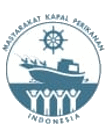NETRALISASI MINYAK HATI IKAN CUCUT PISANG (Charcarinus falciformis) MENGGUNAKAN NaOH
Abstract
The shark has a yield by-product from its liver up to 20% of its body weight, 50% of the total fish oil found on the liver. The aimed of this study was to determine heavy metal content, fatty acid profilel, and parameter of oxidation after neutralization. The method of heavy metal test for silky shark oil stated on the SNI and fatty acid analysis referred to AOAC. Neutralization used NaOH 18°Be temperature (40, 50, 60, 70, and 80°C). The result of oil neutralization with NaOH had heavy metal content meet to IFOS (0.1 ppm), fatty acid of SFA was 19.58% , MUFA was 19.26 %, and PUFA was 41.58 %. The oxidation result of silky shark liver oil neutralization indicated the best treatment at 50°C with peroxide value (PV), p-Anisidine value (p-AV), percentage of free fatty acid (% FFA), acid value (AV), and total oxidation (TOTOX) were 72,49±0,27 mEq/kg, 8,57±0,46 mEq/kg, 0,28±0,00%, 0,56±0,00 mg KOH/kg, 13,57±1,01 mEq/kg respectively.
Full Text:
PDFReferences
Abdillah, M. H. 2008. Pemurnian minyak dari limbah pengolahan ikan. [skripsi]. Bogor (ID): Institut Pertanian Bogor.
Aidos I., van-der-Padt A., Boom R. M & Luten J. B. 2002. Seasonal changes in crude and lipid composition of herring fillets, by-products and respective produced oils. Journal of Agricultural and Food Chemistry. 50: 4589-4599.
[AOAC] Association of Official Analytical Chemist. 2005. Official Method of Analysis of the Association of Official Analytical of Chemist. Arlington: The Association of Analytical Chemist, Inc.
[AOCS] American Oil Chemists Society. 1998. Official Methods and Recommended Practices of the American Oil Chemists’ Society. Champaign: AOCS Press.
Bernardini E. 1983. Vegetable Oils an Fats Processing. Italy (IT): Intertamps House.
Bimbo A. P. 1998. Guidelines for characterizing food-grade fish oil. Inform, 9: 473-483.
Bonfil R., Amorim A., Anderson C., Arauz R., Baum J., Clarke S. C., Graham R. T., Gonzalez M., Jolón M., Kyne P. M., Mancini P., Márquez F., Ruíz C. & Smith W. 2009. Carcharhinus falciformis. The IUCN Red List of Threatened Species.
[BSN] Badan Standardisasi Nasional. 2009. Tentang Batas Maksimum Cemaran Logam Berat dalam Pangan. SNI 7387:2009. Jakarta: Badan Standarisasi Nasional.
Damongilala L. J. 2008. Kandungan asam lemak tak jenuh minyak hati ikan cucut botol (Centrophorus sp.) yang diekstraksi dengan cara pemanasan. Jurnal Ilmiah Sains. 2(8): 249-253.
[EC] European Commission. 2006. Commission regulation (EC) No 1199/2006 amending regulation (EC) No 466/2001 setting maximum levels for certain contaminants in food stuffs as regards dioxins and dioxin-like PCBs. Off. J. EU, L32/34.
Edward H. G. Jr. 1976. Fatty Acid Composition. Di dalam Stansby ME. Fish Oils, Their Chemistry, Technology, Stability, Nutritional, Properties, and Uses. Westport Connecticut (US): The AVI Publishing Company, Inc.
Feryana I. W. K., Suseno S. H. & Nurjanah. 2014. Pemurnian minyak ikan makerel hasil samping penepungan dengan netralisasi alkali. Jurnal Pengolahan Hasil Perikanan Indonesia. 17: 207-214.
Hernandez E. & Rathbone S. 2002. Refining of glyseride oils by treatment with silicate solutions and filtration. US Patent 6: 448-453.
Huli L. O., Suseno S. H. & Santoso J. 2014. Kualitas minyak ikan dari kulit ikan swangi. Jurnal Pengolahan Hasil Perikanan Indonesia. 17 (3): 233-242.
[IFOS] International Fish Oils Standard. 2011. Fish Oil Purity Standards. http://www.omegavia.com/best-fish-oil-supplement-3/ [26 Maret 2016].
Ketaren S. 2008. Pengantar Teknologi Minyak dan Lemak Pangan. Bogor (ID): Pusat Antar Universitas Pangan dan Gizi, Institut Pertanian Bogor.
Kjerstad M., Fosse I. & Willemsem H. 2003. Utilization of deep–sea sharks at Hatton Bank in the North Atlantic. Journal of Northwest Atlantic Fisheries Science. (31): 333–338.
Navarro G., Pacheco R., Vallejo B., Ramirez J. & Bolaños A. 2000. Lipid composition of the liver oil of shark species from the Caribbean and Gulf of California waters. Journal of Food Composition and Analysis. 13: 791-798.
O’Brien R. D. 2009. Fats and oils: Formulating and processing for application, 3rd edition, London (UK): CRC press.
Perrin J. L. 1996. Determination of Alteration. In: Karleskind A, Wolff JP. (Eds.) Oils and Fats, Manual vol. 2. France (FR): Lavoisier Publishing.
Pratama R. I., Awaludin M. Y. & Ishmayan S. 2011. Komposisi asam lemak ikan tongkol, layur, dan tenggiri dari Pameungpeuk, Garut. Jurnal Akuatika. 2(2): 107-115.
Rochyatun E. & Rozak A. 2007. Pemantauan kadar logam berat dalam sedimen di perairan teluk Jakarta. Jurnal Makara, Sains. 11: 28-36.
Sathivel S., Prinyawiwatkul W., King J. M., Grimm C. C. & Lloyd S. 2003. Oil production from catfish viscera. Journal of American Oil Chemistry Society. 80(4): 277–382.
Setiono E. H. 2002. Pemurnian minyak kasar hati ikan cucut (crude shark liver oil) dengan metode netralisasi dan pemucatan [skripsi]. Bogor: Institut Pertanian Bogor.
Suseno S.H. & Saraswati. 2015. Teknologi Industri Minyak Ikan. Bogor (ID) : IPB Press.
Suseno S.H., Syari C., Zakiyah E.R., Jacoeb A. M., Izaki A.Y.,
Saraswati & Hayati S. 2014. Low temperature extraction and quality of oil from spotted sardinella (Amblygaster srim) and goldstrip sardinella (Sardinella gibbosa). World Journal of Fish and Marine Sciences. 6(5): 435-440.
Suseno S. H. 2014. Fatty acid profiles of tropical eel (Anguila sp.) by-products. Advance Journal of Food Science and Technology. 6(6): 802-806.
Suseno S. H. 2015. Proximate, fatty acid, amino acid and mineral composition of tuna (Thunnus sp.) by-product from West Sumatra Povince, Indonesia. Pakistan Journal of Nutrition. 14(1): 62-66.
Undjung D. 2005. Continous production of pure squalene by using column chomatography. Indo. J. Chem. 5(3): 251-254.
Walpole & Ronald E. 1995. Pengantar Statistika. Edisi ke-3. Bandung (ID): Institut Teknologi Bandung.
Watson CA. 1994. Official and standardized methods of analysis (Third Ed.). Cambridge (UK): The Royal Society of Chemistry.
DOI: https://doi.org/10.35308/jpt.v3i2.44
Refbacks
- There are currently no refbacks.
Copyright (c) 2018 Jurnal Perikanan Tropis
Jurnal Perikanan Tropis (print ISSN 2355-5564 ;online ISSN 2355-5572), is published by the Faculty of Fisheries and Marine Science Universitas Teuku Umar, Indonesia .

This work is licensed under a Creative Commons Attribution-NonCommercial-ShareAlike 4.0 International License










